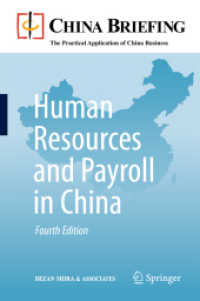基本説明
The book compares and contrasts the legal, practical and institutional approaches to the issue in the European Union, the United Kingdom, the United States, the Republic of South Africa and the World Bank.
Full Description
Anti-corruption measures have firmly taken centre stage in the development agenda of international organisations as well as in developed and developing countries. One area in which corruption manifests itself is in public procurement and, as a result, States have adopted various measures to prevent and curb corruption in public procurement. One such mechanism for dealing with procurement corruption is to debar or disqualify corrupt suppliers from bidding for or otherwise obtaining government contracts.
This book examines the issues and challenges raised by the debarment or disqualification of corrupt suppliers from public contracts. Implementing a disqualification mechanism in public procurement raises serious practical and conceptual difficulties, which are not always considered by legislative provisions on disqualification. Some of the problems that may arise from the use of disqualifications include determining whether a conviction for corruption ought to be a pre-requisite to disqualification, bearing in mind that corruption thrives in secret, resulting in a dearth of convictions. Another issue is determining how to balance the tension between granting adequate procedural safeguards to a supplier in disqualification proceedings and not delaying the procurement process. A further issue is determining the scope of the disqualification in the sense of determining whether it applies to firms, natural persons, subcontractors, subsidiaries or other persons related to the corrupt firm and whether disqualification will lead to the termination of existing contracts.
The book compares and contrasts the legal, practical and institutional approaches to the implementation of the disqualification mechanism in the European Union, the United Kingdom, the United States, the Republic of South Africa and the World Bank.
Contents
1: Introduction
2: Corruption, Anti-Corruption Measures and Disqualification
2.1 Introduction
2.2 The Meaning, Nature and Effects of Corruption
2.3 Anti-Corruption Measures
2.4 Public Procurement And Corruption
2.5 The Use of Disqualifications in Public Procurement
3: An Overview of Procurement Regulation, Anti-Corruption and Disqualification Policy in the Jurisdictions
3.1 Introduction
3.2 The European Union
3.3 The United Kingdom
3.4 The United States
3.5 The World Bank
3.6 South Africa
4: The Offences and the Requirement for a Conviction for Disqualification
4.1 Introduction
4.2 The European Union
4.3. The United Kingdom
4.4 The United States
4.5 The World Bank
4.6 South Africa
4.7 Summary and Analysis of Main Issues
5: Procedural Issues Affecting Disqualification
5.1 Introduction
5.2 Procedure for Disqualifying
5.3 Time Limits for Disqualification
5.4 Summary and Analysis of Main Issues
6: Disqualifying Entities and the Scope of Disqualification
6.1 Introduction
6.2 Disqualifying Entities
6.3 The Scope of Disqualification
6.4 Summary and Analysis of Main Issues
7: Investigations
7.1 Introduction
7.2 The Existence of a Requirement or Obligation to Investigate
7.3 The Entity with the Power to Investigate and the Extent of the Entity's Powers
7.4 The Nature and Sources of Information and Evidence
7.5 Summary and Analysis of Main Issues
8: The Disqualification of Persons Related to a Corrupt Supplier
8.1 Introduction
8.2 Rationales for Disqualifying Related Persons
8.3 The Related Persons
8.4 Summary and Analysis of Main Issues
9: The Effect of Disqualification on Existing Contracts
9.1 Introduction
9.2 Rationales for Contractual Termination
9.3 Is There a Duty to Terminate Existing Contracts for Disqualification?
9.4 Problems with Contractual Termination
9.5 Summary and Analysis of Main Issues
10: Derogating from Disqualification
10.1 Introduction
10.2 Reasons for Derogating from Disqualification
10.3 Preventing Abuse in the Use of Derogations
10.4 Summary and Analysis of Main Issues
11: Remedies for Affected Suppliers
11.1 Introduction
11.2 The Availabilty of a Right of Review
11.3 The Kinds of Remedies Available
11.4 Summary and Analysis of Main Issues








